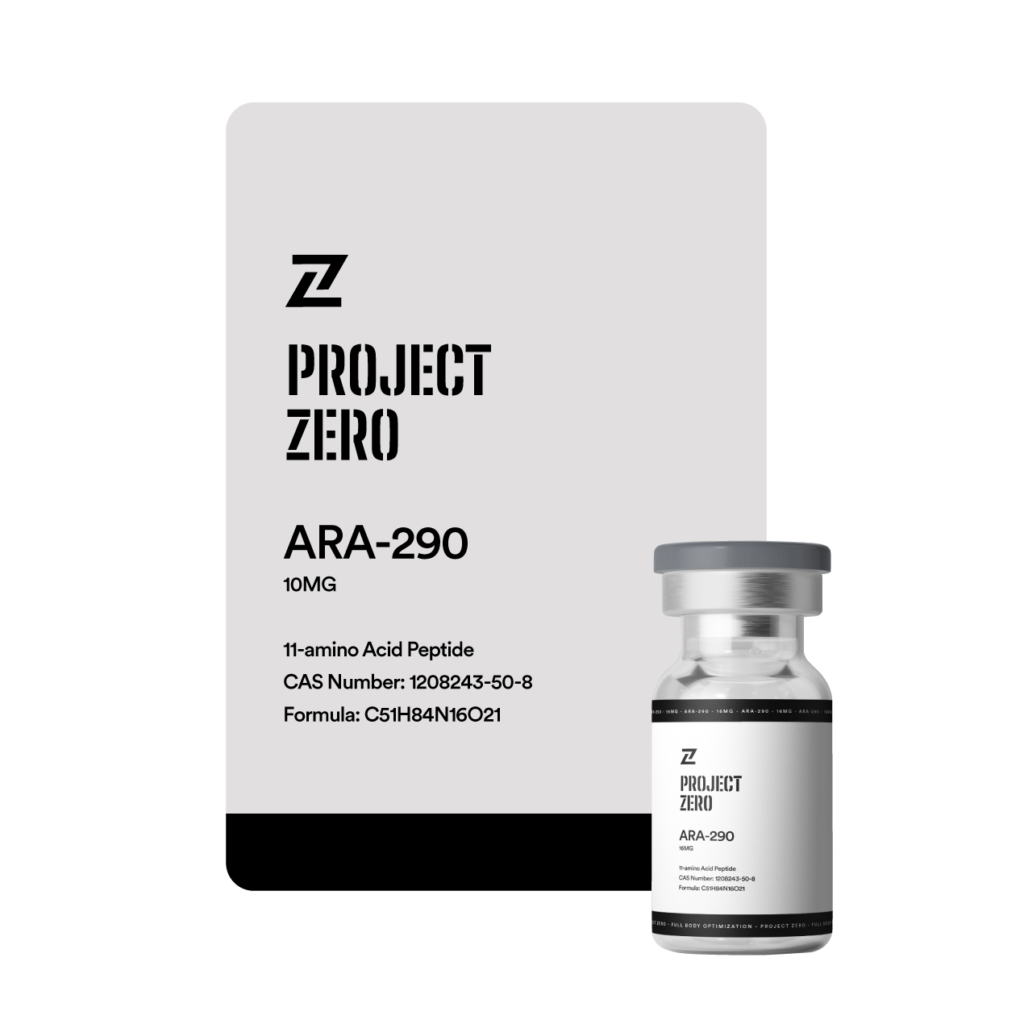ARA-290:
Dosage, Benefits,
and Research Explained
ARA-290 is a synthetic peptide derived from erythropoietin (EPO), specifically designed to provide neuroprotective, anti-inflammatory, and pain-relief benefits without increasing red blood cell production like traditional EPO.
Unlike NSAIDs or opioids, ARA-290 targets inflammatory pathways without harmful side effects, making it a powerful tool for chronic pain and immune regulation.
11-amino Acid Peptide
CAS Number: 120843-50-8
Formula: C51H84N16O21
| Use Case | Common Dosage | Frequency | Duration | Notes |
|---|---|---|---|---|
| Neuropathic Pain Relief | 5-10 mg | 1x daily | 4-8 weeks | Best taken **in the morning or evening**. |
| Inflammation & Autoimmune Support | 5-10 mg | 1x daily | 4-6 weeks | Can be cycled **2-3x per year**. |
| Tissue Repair & Wound Healing | 5-10 mg | 1x daily | 4-6 weeks | Can be stacked with **BPC-157 or TB-500**. |
| Cardiovascular & Metabolic Health | 5-10 mg | 1x daily | Ongoing | Supports **endothelial health & circulation**. |
Overview
ARA-290 is a synthetic peptide derived from erythropoietin (EPO), specifically designed to provide neuroprotective, anti-inflammatory, and pain-relief benefits without increasing red blood cell production like traditional EPO.
ARA-290 is widely used for:
✔ Neuropathic pain relief & nerve repair
✔ Inflammation reduction & immune modulation
✔ Tissue healing & regenerative support
✔ Autoimmune disorder support
✔ Metabolic & cardiovascular health
Unlike NSAIDs or opioids, ARA-290 targets inflammatory pathways without harmful side effects, making it a powerful tool for chronic pain and immune regulation.
How It Works
ARA-290 works by binding to the innate repair receptor (IRR), triggering:
✔ Reduced inflammation & immune modulation
✔ Enhanced nerve regeneration & pain relief
✔ Improved endothelial (blood vessel) health
✔ Increased tissue healing & cellular protection
This makes ARA-290 highly effective for chronic pain conditions, nerve damage, and autoimmune disorders.
Research-Backed Benefits
1. Neuropathic Pain Relief & Nerve Regeneration
- Reduces pain sensitivity and promotes nerve healing.
- Effective for diabetic neuropathy, multiple sclerosis (MS), and nerve injuries.
2. Inflammation Reduction & Autoimmune Support
- Lowers pro-inflammatory cytokines, making it useful for autoimmune diseases & chronic inflammation.
- Can help modulate immune response in conditions like fibromyalgia, lupus, and rheumatoid arthritis.
3. Tissue Repair & Wound Healing
- Stimulates cell regeneration and tissue repair after injury or surgery.
- Used for corneal healing, organ protection, and post-surgical recovery.
4. Cardiovascular & Metabolic Health
- Improves endothelial function, reducing risk of cardiovascular diseases.
- May support metabolic health & insulin sensitivity.
Conclusion
ARA-290 is a powerful neuroprotective & anti-inflammatory peptide, providing nerve regeneration, pain relief, and immune modulation. Whether used for chronic pain, autoimmune support, or cardiovascular health, it remains one of the most promising peptides for long-term wellness.
How does ARA-290 compare to traditional painkillers?
✔ ARA-290 provides long-term nerve healing, unlike opioids or NSAIDs which only mask pain.
✔ ARA-290 reduces inflammation without suppressing the immune system.
How long does it take to see results?
- Pain relief & inflammation reduction: Within 1-2 weeks.
- Nerve regeneration & healing: Noticeable in 4-6 weeks.
- Cardiovascular & metabolic benefits: Long-term, cumulative effects.
Are there any side effects?
ARA-290 is well-tolerated, but possible mild side effects include:
✔ Mild dizziness or fatigue (rare, at higher doses)
✔ Temporary flushing
Tip: If experiencing dizziness, lower the dose and gradually increase.
Can ARA-290 be stacked with other peptides?
✔ ARA-290 + BPC-157 + TB-500 → For full-body healing & nerve repair.
✔ ARA-290 + NAD+ → For longevity & mitochondrial support.
✔ ARA-290 + DSIP → For stress reduction & improved sleep.
Referenced Citations
- Stier, H., et al. (2013). Safety and Tolerability of the Hexadecapeptide AOD9604 in Humans. Journal of Endocrinology and Metabolism, 3(1-2), 7-15. [Online].
Available: https://jofem.org/index.php/jofem/article/view/157/194 - Cox, H. D., et al. (2015). Detection and in vitro metabolism of AOD9604. Drug Testing and Analysis, 7(1), 31-38. [Online].
Available: https://onlinelibrary.wiley.com/doi/pdf/10.1002/dta.1715 - SZieba, R., et al. (2014). Effect of Intra-articular Injection of AOD9604 with or without Hyaluronic Acid in Rabbit Osteoarthritis Model. Annals of Clinical & Laboratory Science, 45(4), 426-432. [Online].
Available: http://www.annclinlabsci.org/content/45/4/426.full - Valentino, M. A., et al. (2010). Obesity Pharmacotherapy: Current Perspectives and Future Directions. Clinical Pharmacology & Therapeutics, 87(6), 650-661. [Online].
Available: https://www.ncbi.nlm.nih.gov/pmc/articles/PMC3584306/ - RegenX Health. (2023). The Journey of AOD-9604: From Clinical Trials to Cosmetic Triumphs. [Online].
Available:https://www.regenxhealth.com/post/the-journey-of-aod-9604-from-clinical-trials-to-cosmetic-triumphs - Stier, H., et al. (2018). Safety and Metabolism of AOD9604, a Novel Nutraceutical Ingredient for Improved Metabolic Health. Journal of Endocrinology and Metabolism, 8(6), 107-116. [Online].
Available: https://jofem.org/index.php/jofem/article/view/213/278
